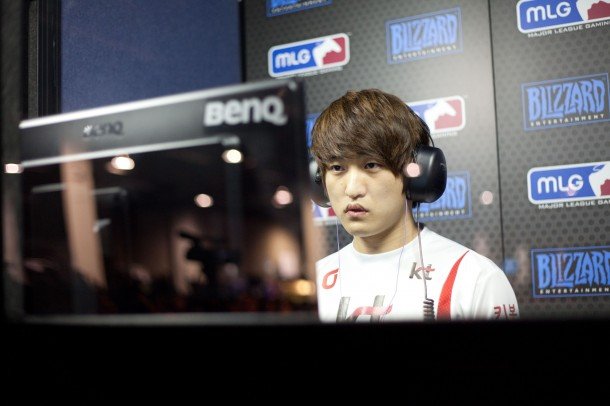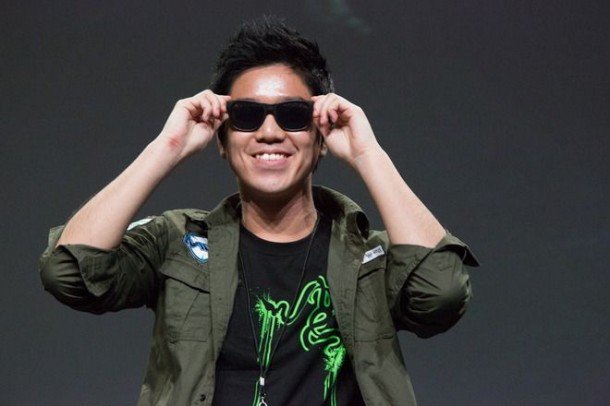Flash of greatness: StarCraft pro-gaming explored

This article originally appeared in issue 243 of PC Gamer UK.
Lee Young Ho sits in the lobby of the Anaheim Hilton hotel. He's five feet ten, wearing a black and white jacket, and armed with an easy, toothy smile. He flashes it at his friends as they chat among themselves. Around them swarm suited Japanese businessmen trailing wheeled suitcases; American families clad in various-sized versions of the same khaki-coloured shorts on their way to Disneyland; and transplanted Texans in stetsons and buttoned-up dress shirts, their faces pink and swollen from the Californian heat outside. Few eyes flick toward Lee Young Ho.
Five hundred metres down the road and two hours later, and Lee Young Ho is waiting to come on stage. He's still with his friends – off to the left of the dais and shrouded in darkness – but his smile has dropped. He talks behind his hand. His eyes scan a space so massive it could comfortably house a few Boeing 747s.
He's called by a bellowing announcer – the syllables extended longer with each phase of his Korean name – and he steps out in front of the crowd assembled for Major League Gaming's Anaheim Spring Championship. Eight thousand people roar in unison. All eyes are locked directly on Lee Young Ho.

Lee Young Ho is better known as Flash, at least outside of his native South Korea. As Flash, he's been playing StarCraft: Brood War professionally for five years. More importantly, he's been winning. Flash's record is superlative: since joining the Korean StarCraft scene in 2007, he's notched up 17 first place finishes in major tournaments, and broken StarCraft's Elo record (a measure of relative skill level devised for chess players) a staggering six times – all previous records having been set by Lee himself.
His appearance at MLG Anaheim is a major coup for Blizzard, the developer of both the original StarCraft and its sequel. It's this newer game that Flash and friends are here to play – for the first time in front of a crowd, all eight of them will play StarCraft II.
StarCraft: Brood War still clings to dominance in South Korea. Teams are established entities with mad, corporate names: CJ Entus, KT Rolster. The country's army and airforce both have teams, made up from ex-professionals drafted in by virtue of the country's mandatory military service. All are overseen by established Korean e-sports bodies, monolithic organisations such as KeSPA: the Korean e-Sports Association.
Keep up to date with the most important stories and the best deals, as picked by the PC Gamer team.

KeSPA appear almost comically inflexible – a player once faced disqualification in a tournament for requesting a pause with the letters 'pp'. The tournament's decided code was 'ppp'. KeSPA has been cool on the concept of StarCraft II since its launch in 2010. Understandably so, to some – as an organisation built around one core game, to jettison that title is to risk losing a decade's worth of fans. But corporate wranglings have also halted the organisation's switchover to a newer, prettier, e-sport. The rise of StarCraft in South Korea was such a freak occurrence that developers Blizzard never built the financial infrastructure to allow other companies to rebroadcast footage. With StarCraft II, the developer decided they wouldn't make the same mistake. Blizzard were unable to reach broadcast terms with KeSPA before the launch of StarCraft II, meaning the Korean company were unable to show the game on TV or online. The smaller, nimbler GomTV stepped into the void, and became South Korea's only licenced e-sports broadcaster. KeSPA – with its stable of preternaturally gifted pro-gamers – stayed rooted in the last century.
Until now, that is. A softening of hearts – or a cold recalculation of economic factors, depending on your world view – led KeSPA back into talks with Blizzard. Behind closed doors, the companies acquiesced to each other's demands, and the Korean group agreed to start showing StarCraft II. But most importantly, they agreed to bring their star players across to the newer game. MLG Anaheim was chosen to be the venue for their unveiling, as eight of the world's best Brood War players – Flash being one of them – were to play in a knockout tournament.

